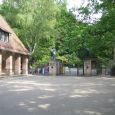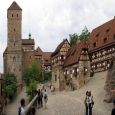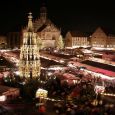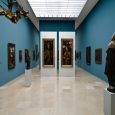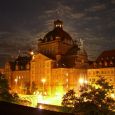Nuremberg
Advertisement
By Air
Nuremberg Airport has flights to major German cities and many European destinations, as well as connecting flights worldwide, for example via Frankfurt or Vienna.Air Berlin uses Nuremberg Airport as the airline's hub, especially in the winter season.
By Train
Nurnberg Hauptbahnhof is a stop for IC and ICE trains on the German long-distance railway network.The Nuremberg–Ingolstadt–Munich High-Speed line with 300 km/h operation opened May 28, 2006, and was fully integrated into the rail schedule on December 10, 2006.Travel times to Munich have been reduced to as little as one hour.
By Road
Nuremberg is conveniently located at the junction of several important Autobahn routes.The A3 (Netherlands–Frankfurt–Würzburg–Vienna) passes in a south-easterly direction along the north-east of the city.The A9 (Berlin–Munich) passes in a north–south direction on the east of the city.The A6 (France–Saarbrücken–Prague) passes in an east–west direction to the south of the city.Finally, the A73 begins in the south-east of Nuremberg and travels north-west through the city before continuing towards Fürth and Bamberg.
Germanisches National museum
is a museum in Nuremberg, Germany. Founded in 1852, houses a large collection of items relating to German culture and art extending from prehistoric times through to the present day. With current overall holdings of about 1.2 million objects, the Germanisches Nationalmuseum is Germany's largest museum of cultural history.Formerly the Germanisches Museum, it was founded by a group of individuals led by Franconian baron, Hans von und zu Aufsess, whose goal was to assemble a "well-ordered compendium of all available source material for German history, literature and art".The buildings incorporate the remaining structures of the former Nuremberg Charterhouse, dissolved in 1525 and used for a variety of secular purposes until in 1857 what was left of the premises, by then badly dilapidated, was given to the Museum.
Christmas market
is a market held annually in Nuremberg, Germany.It takes place during Advent in the Hauptmarkt, the central squaree in Nuremberg’s old town, and in adjoining squares and streets. With about two million visitors a year the Nürnberger Christkindlesmarkt is one of the largest Christmas markets in Germany and one of the most famous in the world. Every year the Christmas market begins on the Friday preceding the first Sunday in Advent and ends on December 24, unless that day is a Sunday.
St. Sebaldus Church
is a medieval church in Nuremberg, Germany. Along with Frauenkirche (Our Lady's Church) and St. Lorenz, it is one of the most important churches of the city, and also one of the oldest. It is located at the Albrecht-Dürer-Platz, in front of the old city hall. It takes its name from Sebaldus, an 8th century hermit and missionary and patron saint of Nuremberg. It has been a Lutheran parish church since the Reformation.
The Nuremberg State Theatre
founded in 1906, is dedicated to all types of Opera, Ballets and Theatre (drama). During the season 2009/2010, the theatre presented 651 performances for an audience of 240,000 persons.
Nuremberg Castle
is a historical building on a sandstone rock in the north of the historical city of Nuremberg, Bavaria, Germany. It comprises three sections: the imperial castle ("Kaiserburg"), some buildings of the Burgraves of Nuremberg ("Burggrafenburg"), and the municipal buildings of the Imperial City at the eastern site ("Reichsstädtische Bauten").Archeological investigations during recent days indicate that the place was already settled around the year 1000, although this has not been backed up by any documentary proof. Nuremberg was first recorded in 1050, when Henry III visited the town, but there is no specific mention of the castle. The castle does not appear in any documents until 1105.In 1140, King Conrad III started building a second castle on the site, to be used as a royal residence.
German National Railways Museum
The beginnings of the museum stretch far back to before its opening in 1899. As early as 1882, the Bavarian State Railway founded a small museum for Bavarian railway history in Munich. Some years later, Nuremberg’s historically-minded mayor, Georg von Schuh, took the collection to Franconia.In the spring of 1899, he offered to hand over an exhibition building located at Marientorgraben to the Bavarian railway administration at no cost. The “Royal Bavarian Railway Museum” was opened a few months later. In 1902, the official opening of a new department for Postal and Telegraph Services was celebrated. The railway museum was subsequently renamed the “Royal Bavarian Transport Museum”.
Nuremberg Zoo
is a zoo located in the Nuremberg Reichswald ("imperial forest"), southeast of Nuremberg, Germany. With an area of 0.67 square kilometres (170 acres), approximately 300 animal species are kept by the zoo.It is one of the largest European zoos. Typical are large, natural enclosures, which are embedded in a landscape of forests and stone pits. More than one million visitors are counted every year. Many new enclosures, e.g., for gorillas, snow leopards and polar bears, were built in recent years. Flocke, a captive-born polar bear who was born at the zoo in December 2007, became a popular tourist attraction and an international celebrity after a controversial decision to remove her from her mother and raise her by hand. Flocke has since been "adopted" by United Nations Environment Programme chief Achim Steiner.
Information not available


